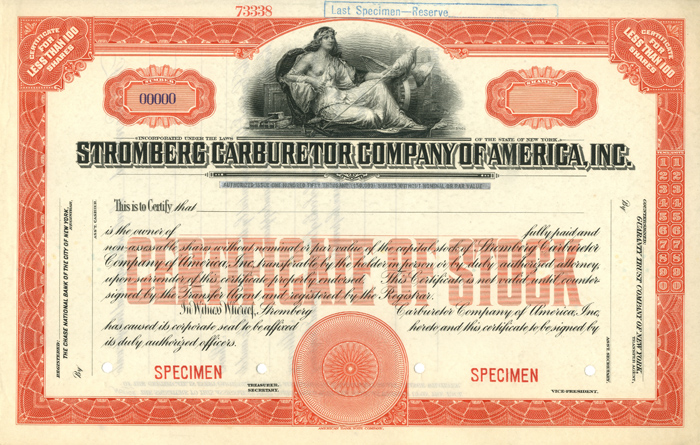Stromberg Carburetor Co. of America, Inc - Specimen Stock Certificate
Inv# SE1366 Specimen Stock
Specimen Stock. Printed by American Bank Note Company. Zenith's most recognized products included the Zenith-Stromberg carburettors, which were utilized in various vehicles from 1965 to 1967, such as the Humber Super Snipe Series Va/Vb and Humber Imperial. Additionally, these carburettors were featured in the 1967 to 1975 Jaguar E-types, Saab 99s, 90s, and early 900s, as well as the 1969 to 1972 Volvo 140s and 164s. Other models that incorporated these carburettors include the Hillman Minx and Hunter (Arrow) from 1966 to 1979, the Singer Gazelle/Vogue (Arrow) from 1966 to 1970, and the Sunbeam Alpine/Rapier Fastback (Arrow) from 1967 to 1975. Furthermore, the Hillman/Chrysler/Talbot/Sunbeam Avenger/Plymouth Cricket, MGs, and several Triumph models from the 1960s and 1970s also employed these carburettors.
The British-manufactured Zenith/Stromberg carburettors were notably installed on the 1969 Jaguar E-type with a 6-cylinder 4.2-liter engine. In the North American market, the Triumph Spitfire utilized Zenith IV carburettors, while in Australia, the high-performance Holden Torana GTR-XU1 was equipped with the CD-150 and CDS-175 models, which featured a triple-carburettor setup.
The Stromberg carburettor, designed and developed by Dennis Barbet of Standard Triumph and Harry Cartwright of Zenith, was created to circumvent SU's patents. It incorporates a variable venturi mechanism controlled by a piston. This piston is equipped with a long, tapered, conical metering rod, commonly referred to as a "needle," which fits within an orifice known as a "jet." This jet allows fuel to enter the airstream flowing through the carburettor. The tapered design of the needle enables it to open and close the jet's opening as it moves, thereby regulating fuel flow. Consequently, the pistonâs movement determines the quantity of fuel delivered in response to the engine's demands.
Stock and Bond Specimens are made and usually retained by a printer as a record of the contract with a client, generally with manuscript contract notes such as the quantity printed. Specimens are sometimes produced for use by the printing company's sales team as examples of the firms products. These are usually marked "Specimen" and have no serial numbers.










Ebay ID: labarre_galleries